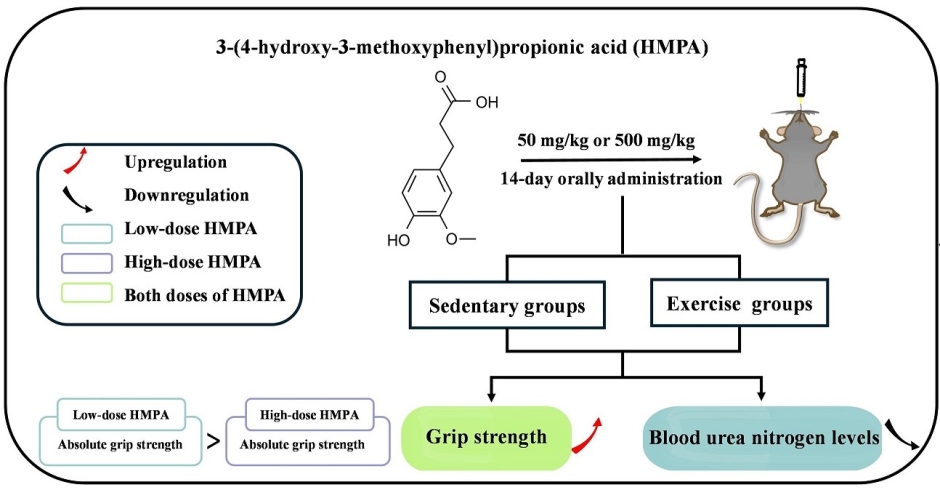- NEWS
- Effects of 3-(4-Hydroxy-3-methoxyphenyl)propionic Acid on Enhancing Grip Strength and Inhibiting Protein Catabolism Induced by Exhaustive Exercise/ジヒドロフェルラ酸が握力向上および疲労困憊運動による筋タンパク質分解抑制に及ぼす影響
Effects of 3-(4-Hydroxy-3-methoxyphenyl)propionic Acid on Enhancing Grip Strength and Inhibiting Protein Catabolism Induced by Exhaustive Exercise/ジヒドロフェルラ酸が握力向上および疲労困憊運動による筋タンパク質分解抑制に及ぼす影響

- Posted
- 2024年12月25日(水)
概要/Abstract
3-(4-Hydroxy-3-methoxyphenyl)propionic acid (HMPA), a gut metabolite derived from various polyphenolic compounds, is known for its antioxidant and anti-obesity effects. However, its impact on muscle function remains unclear. This study investigated the effects of 14-day oral administration of low and high doses of HMPA on muscle strength and endurance capacity in mice. Our results show that HMPA improves muscle strength, and low-dose HMPA reduces plasma levels of blood urea nitrogen. However, HMPA does not enhance exercise endurance capacity in mice. These findings suggest that HMPA could be a promising dietary supplement for improving muscle strength.
本研究では、3-(4-ヒドロキシ-3-メトキシフェニル)プロピオン酸 (HMPA) を低濃度および高濃度で14日間マウスに経口投与し、筋力および持久力への影響を検討しました。その結果、HMPAの投与は筋力を向上させ、低濃度の投与により血中尿素窒素濃度を低下させることから、筋力向上に有望な栄養補助食品と考えられます。
(1)これまでの研究で分かっていたこと/Research Background
HMPA, also known as dihydroferulic acid, is a phenolic compound found in fermented foods and produced as a gut microbial metabolite from ferulic acid, a well-studied phenolic acid with documented antioxidant and metabolic regulatory properties. Microbial metabolites demonstrate the potential to retain the biological activity of their parent compounds and may even exhibit enhanced bioactivity. Compared to ferulic acid, HMPA demonstrates better solubility, higher absorption rates, and superior antioxidant activity. Some of the beneficial effects of ferulic acid are attributed to its microbial metabolite, HMPA. While the effects of ferulic acid on muscle function have been extensively studied, the impact of HMPA on muscle function remains unknown.
HMPA(ジヒドロフェルラ酸)は、発酵食品に含まれるフェノール酸であり、フェルラ酸の腸内代謝物として産生されます。フェルラ酸は、その抗酸化作用および代謝調節作用が広く研究されているフェノール酸です。腸内代謝物は、元の化合物の生理活性を保持するだけでなく、より高い生理活性を示すこともあります。フェルラ酸と比べて、HMPAは優れた水溶性、吸収率および抗酸化作用を示します。フェルラ酸の生理活性の一部は、その腸内代謝物であるHMPAに関連していることが報告されています。フェルラ酸が筋機能に及ぼす影響は広く研究されていますが、HMPAが筋機能に及ぼす影響についてはまだ明らかにされていません。
(2)今回の研究で新たに実現しようとしたこと、明らかになったこと/Findings
This study found that 14-day HMPA administration significantly enhanced grip strength in mice, with low-dose HMPA reducing plasma blood urea nitrogen levels after exhaustive exercise, suggesting its potential in improving muscle strength and reducing protein catabolism. However, it did not improve endurance performance.
本研究では、14日間のHMPA投与により、マウスの握力が有意に向上しました。また、低濃度のHMPA投与は、疲労困憊運動後の血中尿素窒素濃度を低下させることから、筋タンパク質分解の抑制に寄与する可能性が示唆されました。しかし、持久力への影響は認められませんでした。
(3)そのために新しく開発した手法/Methods developed
To investigate the effects of HMPA on muscle function, grip strength and treadmill exhaustion tests were combined to evaluate muscle strength and endurance capacity.
HMPAが筋機能に及ぼす影響を検討するため、握力測定とトレッドミル疲労困憊運動を組み合わせて、筋力および持久力を評価しました。
(4)研究の波及効果や社会的影響/Research implications to the society
The findings demonstrate the potential of HMPA as a dietary supplement to improve muscle function and prevent protein degradation under physical challenge. This could benefit populations experiencing muscle strength decline caused by disuse and aging, or athletes seeking performance enhancement.
HMPAが筋機能を改善し、筋タンパク質の分解を抑制する栄養補助食品としての可能性を示唆しています。これは、廃用や加齢による筋力低下に悩む人々や、運動能力の向上を目指すアスリートにとって有望なサプリメントとなる可能性があります。
(5)今後の課題/Future issues
HMPA is widely recognized for its anti-inflammatory and antioxidant properties. However, its role in mitigating oxidative stress induced by exhaustive exercise remains unexplored in this study. To bridge this gap, future research should prioritize uncovering the underlying mechanisms of HMPA to better understand its potential protective effects during prolonged intense exercise. Additionally, further investigations are needed to establish the long-term safety, efficacy, and optimal dosage of HMPA, and the detailed mechanisms underlying its impact on muscle development and energy metabolism. These efforts should also extend to examining the potential effects of HMPA in models of muscle atrophy or dysfunction. Moreover, conducting well-designed clinical trials in human subjects is essential to validate its therapeutic potential and facilitate its practical application.
HMPAは、その抗炎症作用および抗酸化作用で広く認められています。しかし、本研究では運動誘発性酸化ストレスに対する保護作用はまだ検討されていません。この課題を解決するために、関連するメカニズムを解析し、疲労困憊運動における保護効果を明らかにすることが求められます。また、HMPAの長期的な安全性、有効性、最適な投与量を確立し、筋の発達やエネルギー代謝への影響を解明するためのさらなる研究が必要です。さらに、筋萎縮や筋機能障害モデルにおけるHMPAの効果を検討することも重要です。加えて、ヒト臨床試験を実施し、HMPAの治療への応用可能性を明確にするとともに、実用化を促進する必要があります。
(6)研究者のコメント/Researcher’s Comment
Previous studies on HMPA have predominantly focused on its anti-inflammatory, antioxidant, and anti-obesity properties. This study, however, provides valuable insights into the effects of HMPA on muscle function and metabolism. A 14-day low-dose HMPA administration demonstrated its effect to enhance grip strength and reduce protein catabolism after exhaustive exercise, indicating its potential as a promising natural dietary supplement for improving muscle development and preserving muscle mass. Future research could explore the potential of HMPA in preventing muscle atrophy.
これまでのHMPA研究は、主にその抗炎症作用、抗酸化作用、抗肥満作用に焦点を当ててきました。しかし、本研究では、HMPAが筋機能および代謝に及ぼす影響について新たな知見を提供しています。14日間の低濃度HMPA投与により、筋力の向上や疲労困憊運動後のタンパク質分解の抑制が確認され、筋発達促進および筋量維持に貢献する可能性が示唆されました。今後は、HMPAが筋萎縮予防にどのように寄与するかを明らかにするための研究が必要です。
(7)用語解説/Terminology
※1 Ferulic acid (フェルラ酸)
A natural phenolic compound found in cereals and other plants, known for its diverse health-promoting effects, including antioxidant, anti-inflammatory, and anti-obesity properties.
穀物を含む植物に含まれる天然のフェノール化合物で、抗酸化作用や抗炎症作用、抗肥満作用など多様な健康促進効果を持つ成分です。
※2 腸内代謝産物(Gut microbial metabolites)
Chemical substances produced through the decomposition and metabolism of dietary components or endogenous compounds by gut microbiota.
腸内に存在する微生物(腸内細菌)が食事由来の成分や体内物質を分解・代謝することで生成される化学物質のことです。
(8)論文情報/Journal Information
雑誌名/Journal:International Journal of Molecular Sciences
論文名/Title:Effects of 3-(4-Hydroxy-3-methoxyphenyl)propionic Acid on Enhancing Grip Strength and Inhibiting Protein Catabolism Induced by Exhaustive Exercise
執筆者名・所属機関名/Authors and Affiliated Organisation:童奕珊(早稲田大学)、黄嘉鵬(早稲田大学)、王碩(早稲田大学)、阿波里佳(丸善製薬株式会社)、田川岳(丸善製薬株式会社)、張子薇(早稲田大学)、曹鉄瀚(早稲田大学)、小堀日暉(早稲田大学)、鈴木克彦(早稲田大学)
Publishment Date(Local Time):16 June 2024
Publishment Date(Japan Time):16 June 2024
URL:https://www.mdpi.com/1422-0067/25/12/6627
DOI:https://doi.org/10.3390/ijms25126627
(9)研究助成/Research Grant
This research received external funding from Maruzen Pharmaceuticals Co., Ltd.
